Airborne Oil and Gas Program Charter for TCP Riser Qualification
VerifiedAdded on 2023/06/05
|12
|1667
|379
AI Summary
This program charter outlines the Airborne Oil and Gas program for TCP Riser Qualification for deepwater applications. It includes program overview, business need justification, scope, duration, budget estimate, assumptions, constraints, and risks.
Contribute Materials
Your contribution can guide someone’s learning journey. Share your
documents today.
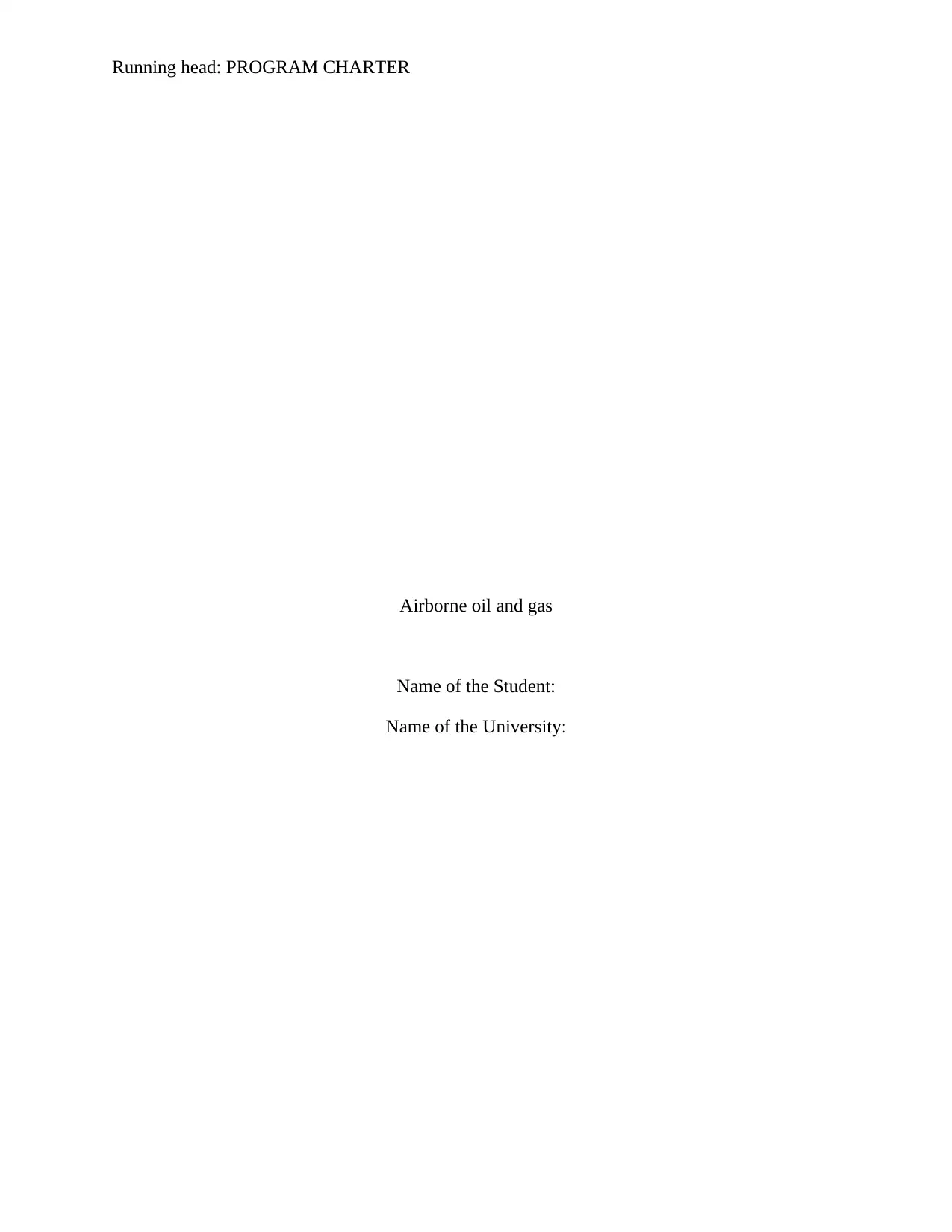
Running head: PROGRAM CHARTER
Airborne oil and gas
Name of the Student:
Name of the University:
Airborne oil and gas
Name of the Student:
Name of the University:
Secure Best Marks with AI Grader
Need help grading? Try our AI Grader for instant feedback on your assignments.
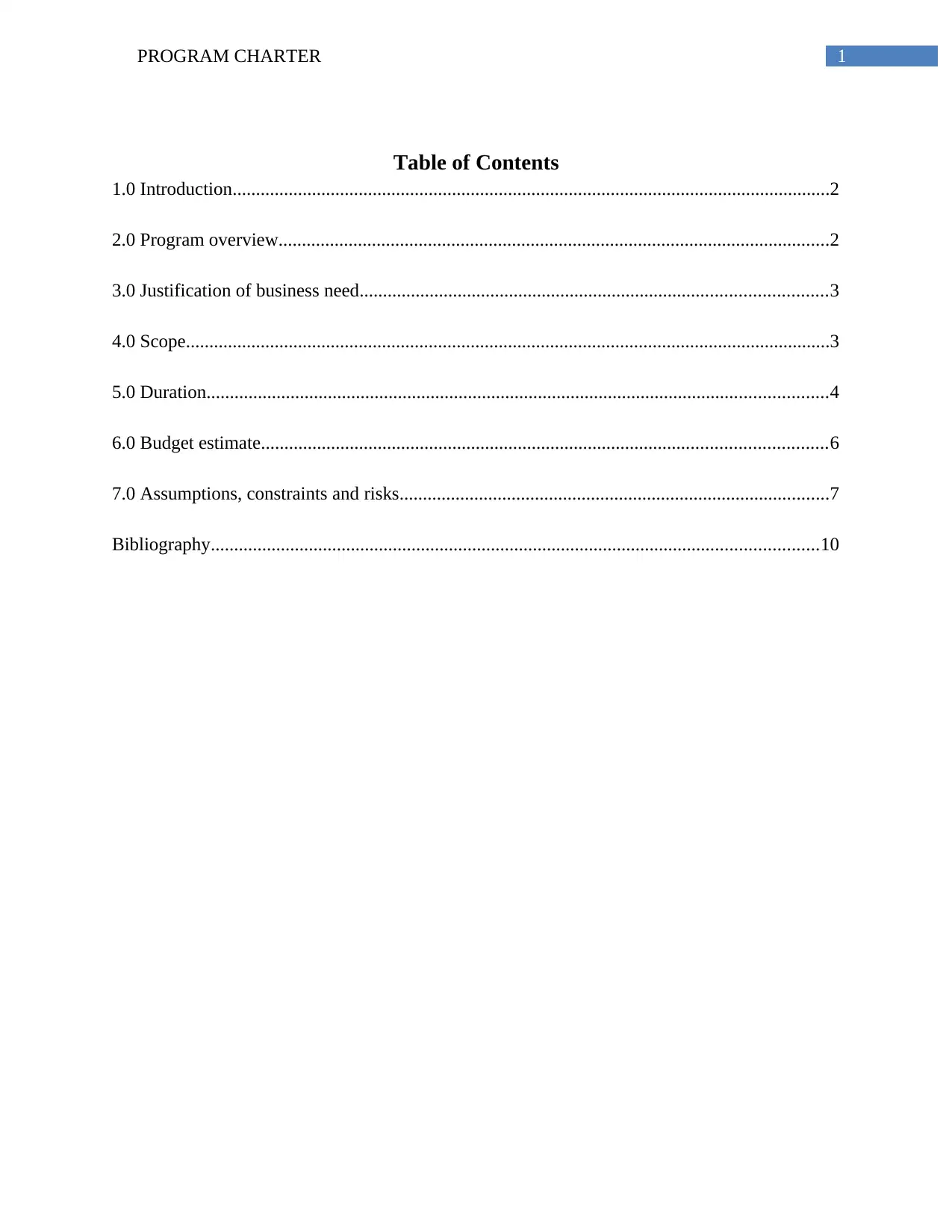
1PROGRAM CHARTER
Table of Contents
1.0 Introduction................................................................................................................................2
2.0 Program overview......................................................................................................................2
3.0 Justification of business need....................................................................................................3
4.0 Scope..........................................................................................................................................3
5.0 Duration.....................................................................................................................................4
6.0 Budget estimate.........................................................................................................................6
7.0 Assumptions, constraints and risks............................................................................................7
Bibliography..................................................................................................................................10
Table of Contents
1.0 Introduction................................................................................................................................2
2.0 Program overview......................................................................................................................2
3.0 Justification of business need....................................................................................................3
4.0 Scope..........................................................................................................................................3
5.0 Duration.....................................................................................................................................4
6.0 Budget estimate.........................................................................................................................6
7.0 Assumptions, constraints and risks............................................................................................7
Bibliography..................................................................................................................................10
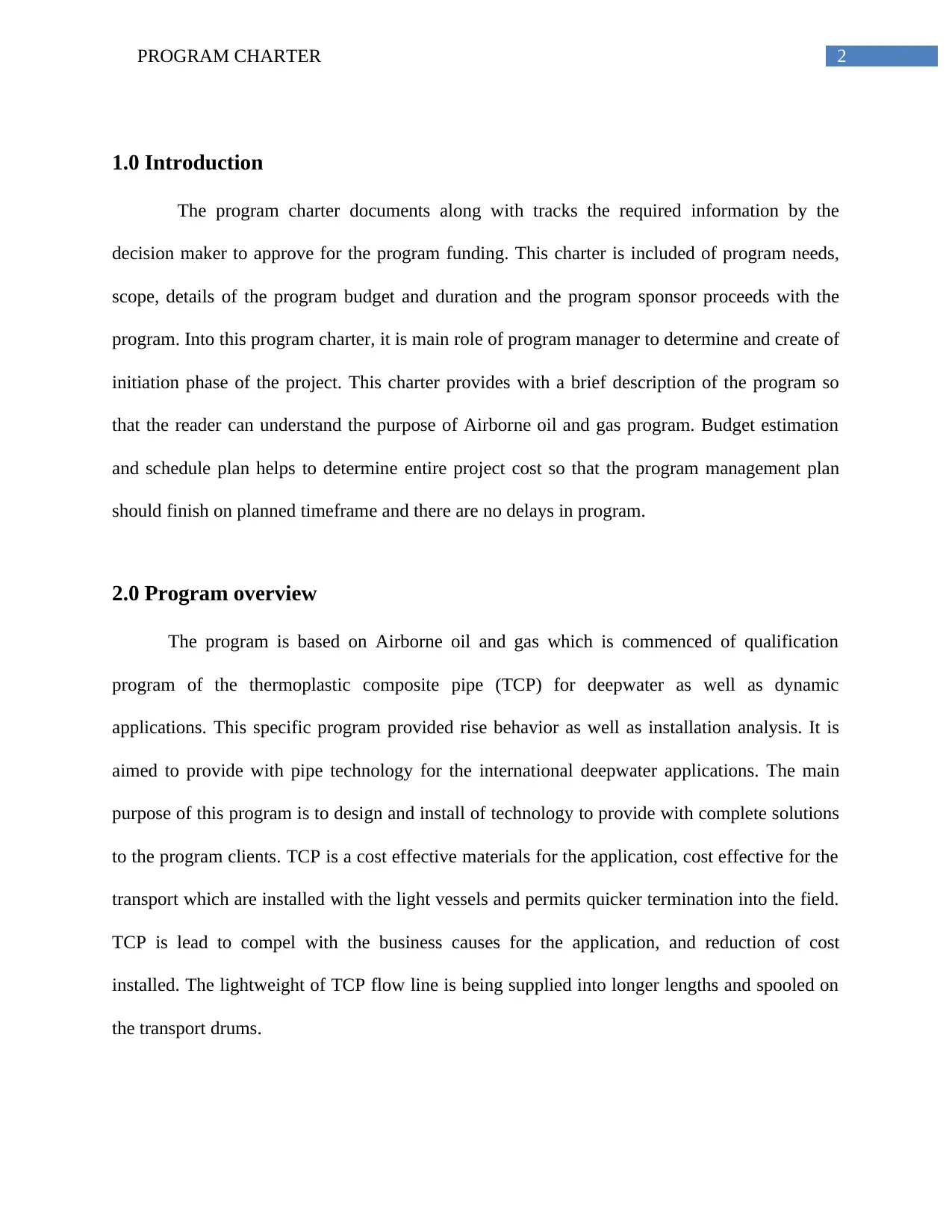
2PROGRAM CHARTER
1.0 Introduction
The program charter documents along with tracks the required information by the
decision maker to approve for the program funding. This charter is included of program needs,
scope, details of the program budget and duration and the program sponsor proceeds with the
program. Into this program charter, it is main role of program manager to determine and create of
initiation phase of the project. This charter provides with a brief description of the program so
that the reader can understand the purpose of Airborne oil and gas program. Budget estimation
and schedule plan helps to determine entire project cost so that the program management plan
should finish on planned timeframe and there are no delays in program.
2.0 Program overview
The program is based on Airborne oil and gas which is commenced of qualification
program of the thermoplastic composite pipe (TCP) for deepwater as well as dynamic
applications. This specific program provided rise behavior as well as installation analysis. It is
aimed to provide with pipe technology for the international deepwater applications. The main
purpose of this program is to design and install of technology to provide with complete solutions
to the program clients. TCP is a cost effective materials for the application, cost effective for the
transport which are installed with the light vessels and permits quicker termination into the field.
TCP is lead to compel with the business causes for the application, and reduction of cost
installed. The lightweight of TCP flow line is being supplied into longer lengths and spooled on
the transport drums.
1.0 Introduction
The program charter documents along with tracks the required information by the
decision maker to approve for the program funding. This charter is included of program needs,
scope, details of the program budget and duration and the program sponsor proceeds with the
program. Into this program charter, it is main role of program manager to determine and create of
initiation phase of the project. This charter provides with a brief description of the program so
that the reader can understand the purpose of Airborne oil and gas program. Budget estimation
and schedule plan helps to determine entire project cost so that the program management plan
should finish on planned timeframe and there are no delays in program.
2.0 Program overview
The program is based on Airborne oil and gas which is commenced of qualification
program of the thermoplastic composite pipe (TCP) for deepwater as well as dynamic
applications. This specific program provided rise behavior as well as installation analysis. It is
aimed to provide with pipe technology for the international deepwater applications. The main
purpose of this program is to design and install of technology to provide with complete solutions
to the program clients. TCP is a cost effective materials for the application, cost effective for the
transport which are installed with the light vessels and permits quicker termination into the field.
TCP is lead to compel with the business causes for the application, and reduction of cost
installed. The lightweight of TCP flow line is being supplied into longer lengths and spooled on
the transport drums.
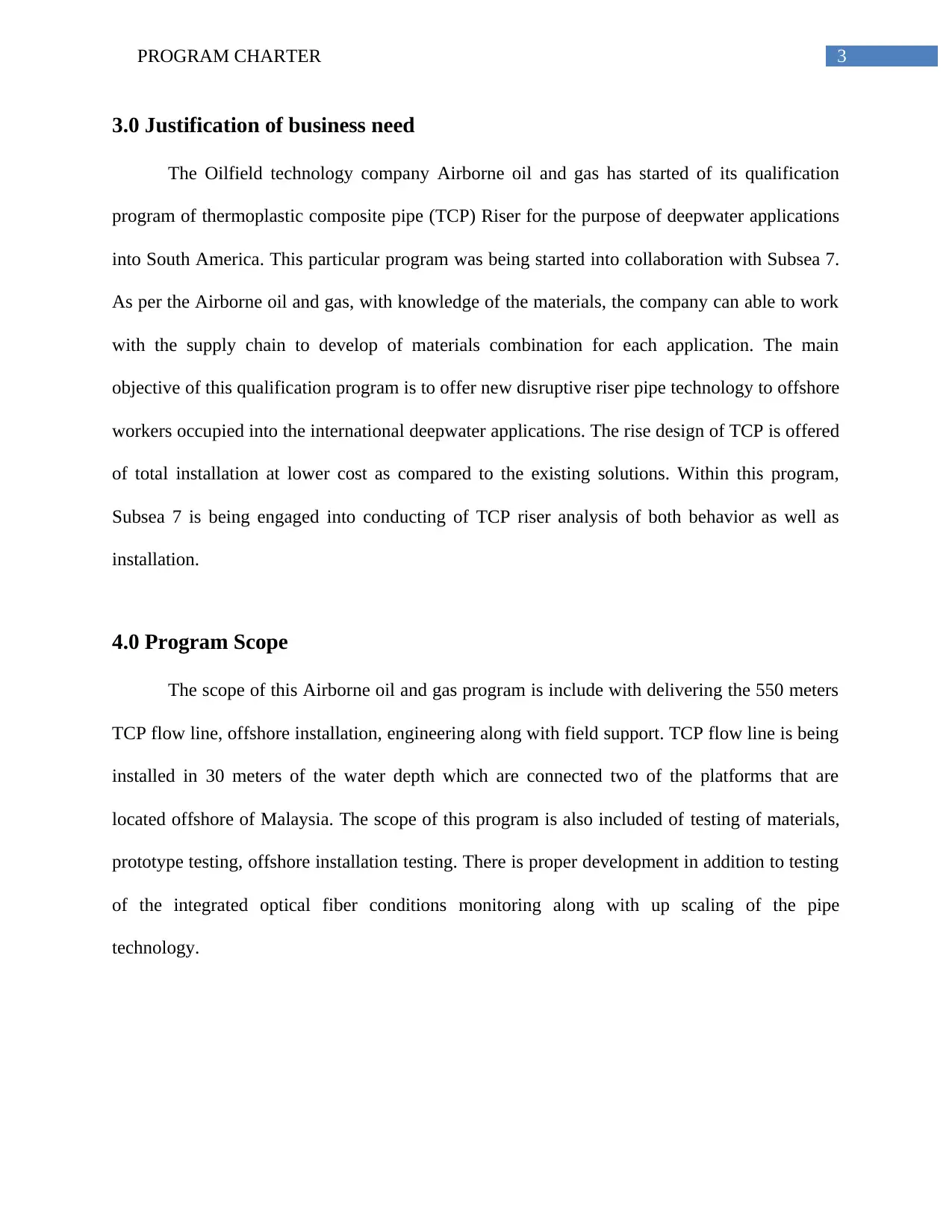
3PROGRAM CHARTER
3.0 Justification of business need
The Oilfield technology company Airborne oil and gas has started of its qualification
program of thermoplastic composite pipe (TCP) Riser for the purpose of deepwater applications
into South America. This particular program was being started into collaboration with Subsea 7.
As per the Airborne oil and gas, with knowledge of the materials, the company can able to work
with the supply chain to develop of materials combination for each application. The main
objective of this qualification program is to offer new disruptive riser pipe technology to offshore
workers occupied into the international deepwater applications. The rise design of TCP is offered
of total installation at lower cost as compared to the existing solutions. Within this program,
Subsea 7 is being engaged into conducting of TCP riser analysis of both behavior as well as
installation.
4.0 Program Scope
The scope of this Airborne oil and gas program is include with delivering the 550 meters
TCP flow line, offshore installation, engineering along with field support. TCP flow line is being
installed in 30 meters of the water depth which are connected two of the platforms that are
located offshore of Malaysia. The scope of this program is also included of testing of materials,
prototype testing, offshore installation testing. There is proper development in addition to testing
of the integrated optical fiber conditions monitoring along with up scaling of the pipe
technology.
3.0 Justification of business need
The Oilfield technology company Airborne oil and gas has started of its qualification
program of thermoplastic composite pipe (TCP) Riser for the purpose of deepwater applications
into South America. This particular program was being started into collaboration with Subsea 7.
As per the Airborne oil and gas, with knowledge of the materials, the company can able to work
with the supply chain to develop of materials combination for each application. The main
objective of this qualification program is to offer new disruptive riser pipe technology to offshore
workers occupied into the international deepwater applications. The rise design of TCP is offered
of total installation at lower cost as compared to the existing solutions. Within this program,
Subsea 7 is being engaged into conducting of TCP riser analysis of both behavior as well as
installation.
4.0 Program Scope
The scope of this Airborne oil and gas program is include with delivering the 550 meters
TCP flow line, offshore installation, engineering along with field support. TCP flow line is being
installed in 30 meters of the water depth which are connected two of the platforms that are
located offshore of Malaysia. The scope of this program is also included of testing of materials,
prototype testing, offshore installation testing. There is proper development in addition to testing
of the integrated optical fiber conditions monitoring along with up scaling of the pipe
technology.
Secure Best Marks with AI Grader
Need help grading? Try our AI Grader for instant feedback on your assignments.
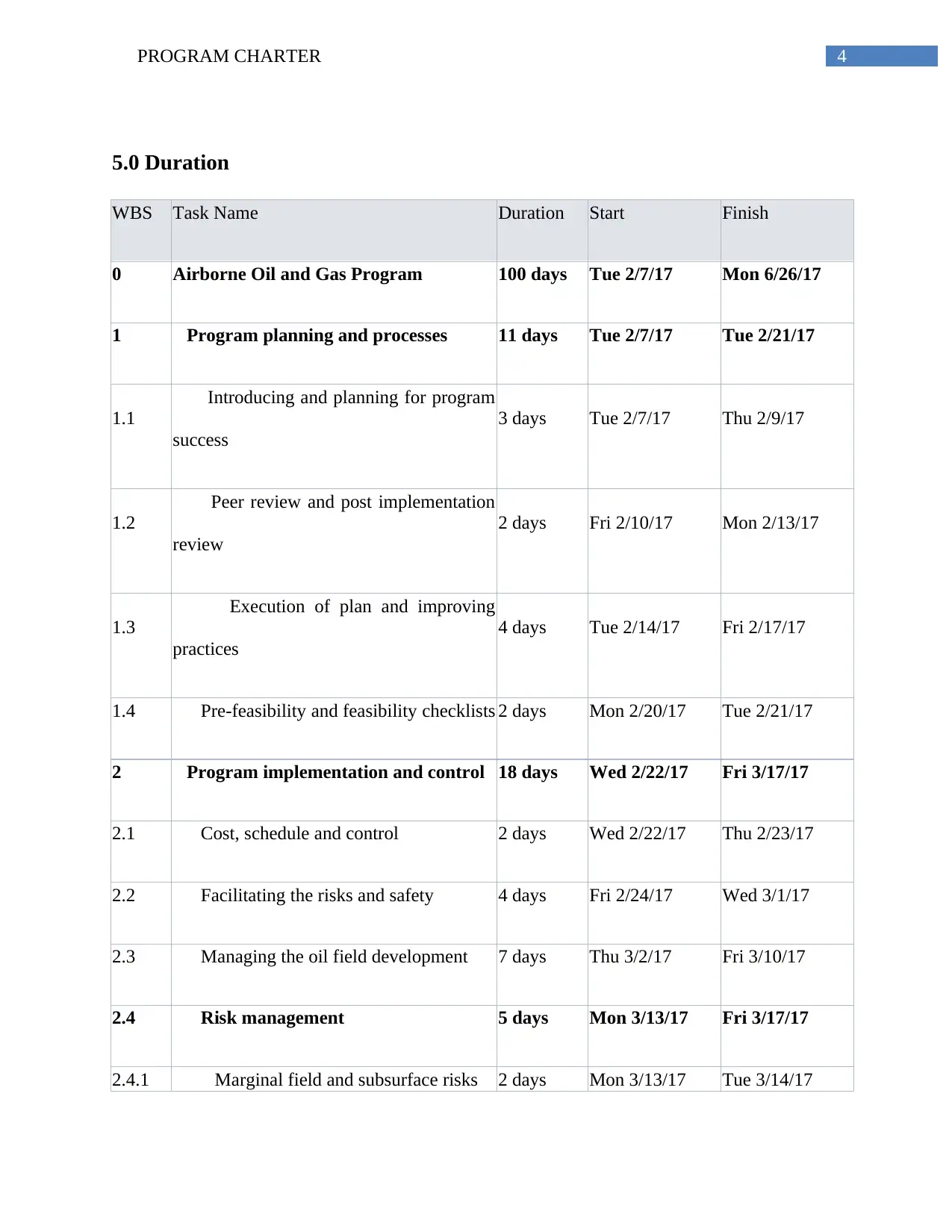
4PROGRAM CHARTER
5.0 Duration
WBS Task Name Duration Start Finish
0 Airborne Oil and Gas Program 100 days Tue 2/7/17 Mon 6/26/17
1 Program planning and processes 11 days Tue 2/7/17 Tue 2/21/17
1.1
Introducing and planning for program
success
3 days Tue 2/7/17 Thu 2/9/17
1.2
Peer review and post implementation
review
2 days Fri 2/10/17 Mon 2/13/17
1.3
Execution of plan and improving
practices
4 days Tue 2/14/17 Fri 2/17/17
1.4 Pre-feasibility and feasibility checklists 2 days Mon 2/20/17 Tue 2/21/17
2 Program implementation and control 18 days Wed 2/22/17 Fri 3/17/17
2.1 Cost, schedule and control 2 days Wed 2/22/17 Thu 2/23/17
2.2 Facilitating the risks and safety 4 days Fri 2/24/17 Wed 3/1/17
2.3 Managing the oil field development 7 days Thu 3/2/17 Fri 3/10/17
2.4 Risk management 5 days Mon 3/13/17 Fri 3/17/17
2.4.1 Marginal field and subsurface risks 2 days Mon 3/13/17 Tue 3/14/17
5.0 Duration
WBS Task Name Duration Start Finish
0 Airborne Oil and Gas Program 100 days Tue 2/7/17 Mon 6/26/17
1 Program planning and processes 11 days Tue 2/7/17 Tue 2/21/17
1.1
Introducing and planning for program
success
3 days Tue 2/7/17 Thu 2/9/17
1.2
Peer review and post implementation
review
2 days Fri 2/10/17 Mon 2/13/17
1.3
Execution of plan and improving
practices
4 days Tue 2/14/17 Fri 2/17/17
1.4 Pre-feasibility and feasibility checklists 2 days Mon 2/20/17 Tue 2/21/17
2 Program implementation and control 18 days Wed 2/22/17 Fri 3/17/17
2.1 Cost, schedule and control 2 days Wed 2/22/17 Thu 2/23/17
2.2 Facilitating the risks and safety 4 days Fri 2/24/17 Wed 3/1/17
2.3 Managing the oil field development 7 days Thu 3/2/17 Fri 3/10/17
2.4 Risk management 5 days Mon 3/13/17 Fri 3/17/17
2.4.1 Marginal field and subsurface risks 2 days Mon 3/13/17 Tue 3/14/17
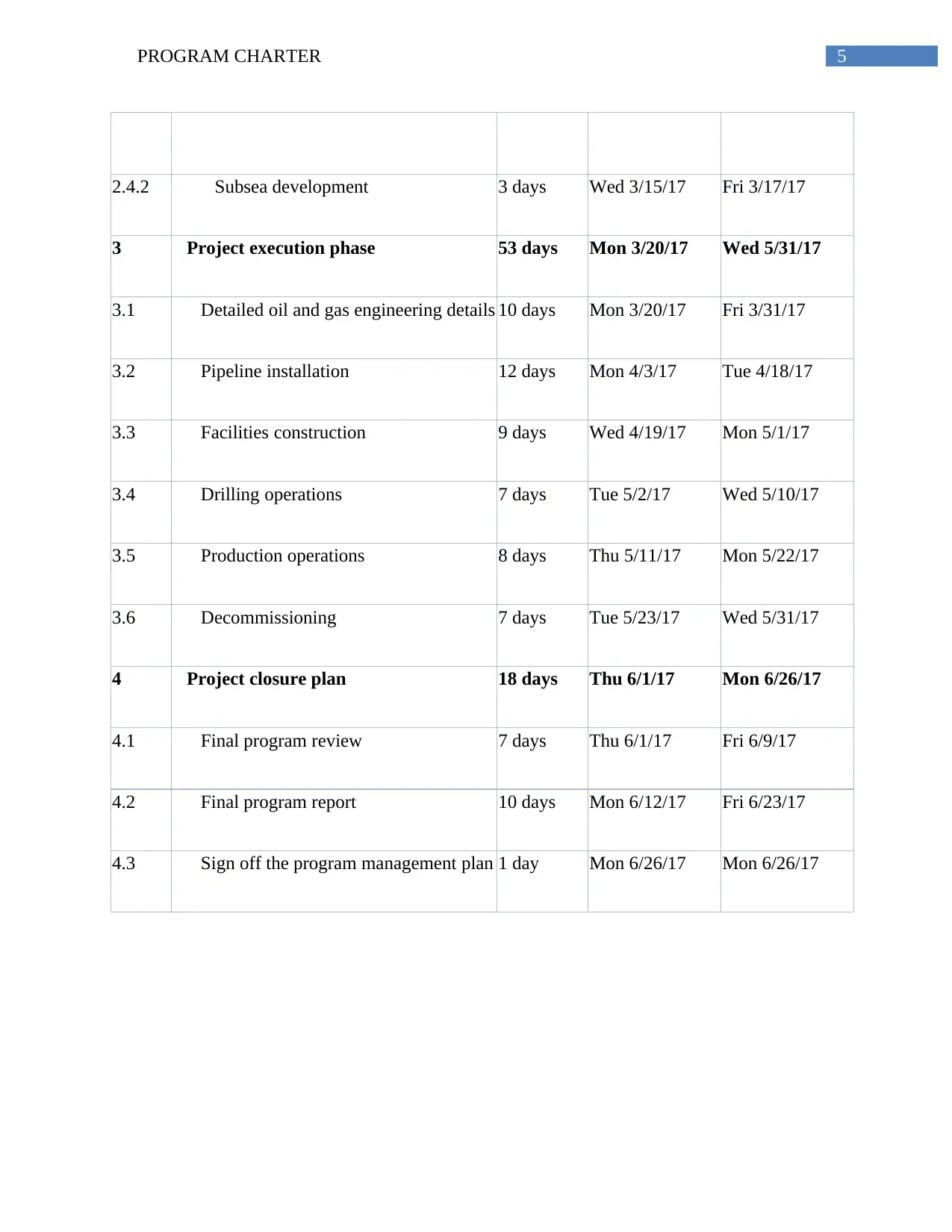
5PROGRAM CHARTER
2.4.2 Subsea development 3 days Wed 3/15/17 Fri 3/17/17
3 Project execution phase 53 days Mon 3/20/17 Wed 5/31/17
3.1 Detailed oil and gas engineering details 10 days Mon 3/20/17 Fri 3/31/17
3.2 Pipeline installation 12 days Mon 4/3/17 Tue 4/18/17
3.3 Facilities construction 9 days Wed 4/19/17 Mon 5/1/17
3.4 Drilling operations 7 days Tue 5/2/17 Wed 5/10/17
3.5 Production operations 8 days Thu 5/11/17 Mon 5/22/17
3.6 Decommissioning 7 days Tue 5/23/17 Wed 5/31/17
4 Project closure plan 18 days Thu 6/1/17 Mon 6/26/17
4.1 Final program review 7 days Thu 6/1/17 Fri 6/9/17
4.2 Final program report 10 days Mon 6/12/17 Fri 6/23/17
4.3 Sign off the program management plan 1 day Mon 6/26/17 Mon 6/26/17
2.4.2 Subsea development 3 days Wed 3/15/17 Fri 3/17/17
3 Project execution phase 53 days Mon 3/20/17 Wed 5/31/17
3.1 Detailed oil and gas engineering details 10 days Mon 3/20/17 Fri 3/31/17
3.2 Pipeline installation 12 days Mon 4/3/17 Tue 4/18/17
3.3 Facilities construction 9 days Wed 4/19/17 Mon 5/1/17
3.4 Drilling operations 7 days Tue 5/2/17 Wed 5/10/17
3.5 Production operations 8 days Thu 5/11/17 Mon 5/22/17
3.6 Decommissioning 7 days Tue 5/23/17 Wed 5/31/17
4 Project closure plan 18 days Thu 6/1/17 Mon 6/26/17
4.1 Final program review 7 days Thu 6/1/17 Fri 6/9/17
4.2 Final program report 10 days Mon 6/12/17 Fri 6/23/17
4.3 Sign off the program management plan 1 day Mon 6/26/17 Mon 6/26/17
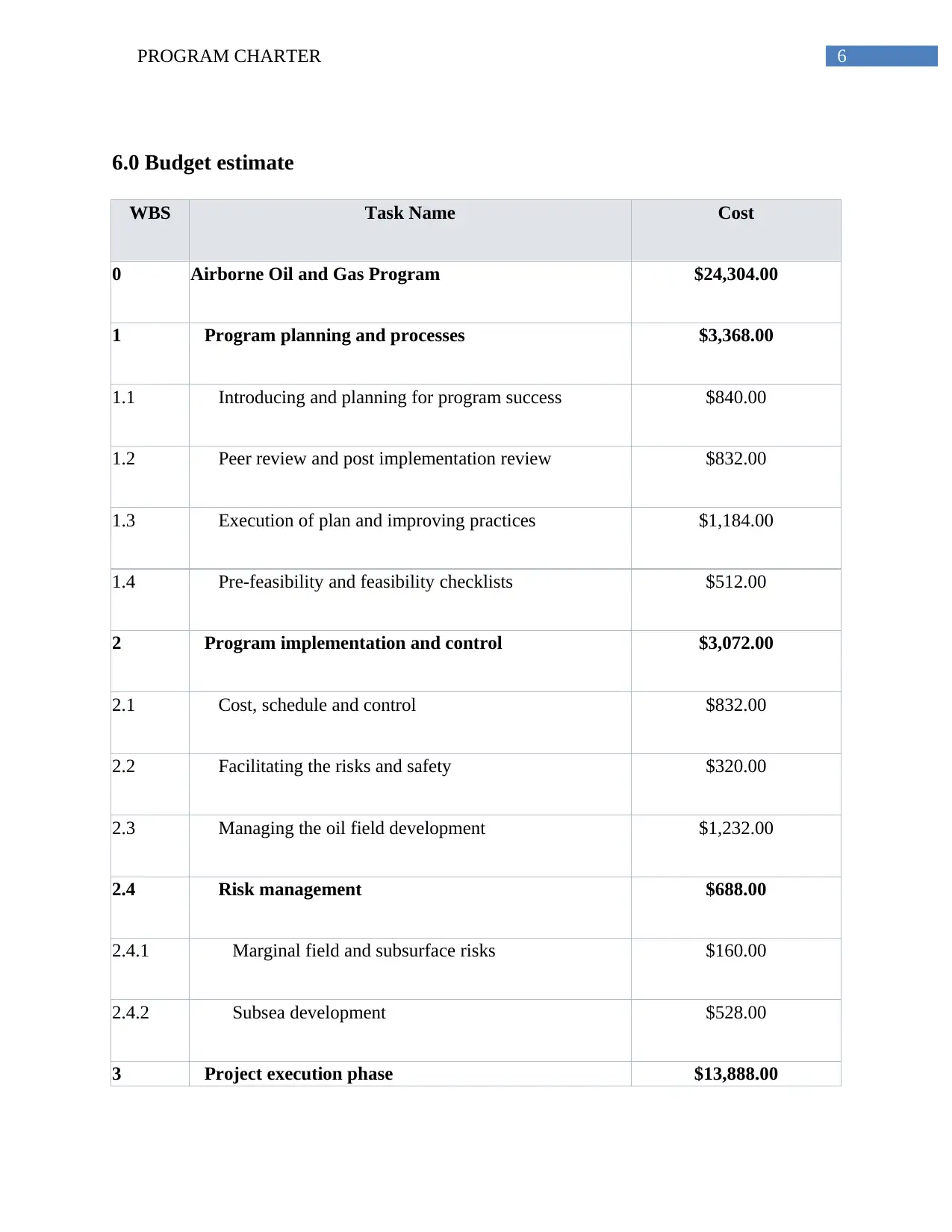
6PROGRAM CHARTER
6.0 Budget estimate
WBS Task Name Cost
0 Airborne Oil and Gas Program $24,304.00
1 Program planning and processes $3,368.00
1.1 Introducing and planning for program success $840.00
1.2 Peer review and post implementation review $832.00
1.3 Execution of plan and improving practices $1,184.00
1.4 Pre-feasibility and feasibility checklists $512.00
2 Program implementation and control $3,072.00
2.1 Cost, schedule and control $832.00
2.2 Facilitating the risks and safety $320.00
2.3 Managing the oil field development $1,232.00
2.4 Risk management $688.00
2.4.1 Marginal field and subsurface risks $160.00
2.4.2 Subsea development $528.00
3 Project execution phase $13,888.00
6.0 Budget estimate
WBS Task Name Cost
0 Airborne Oil and Gas Program $24,304.00
1 Program planning and processes $3,368.00
1.1 Introducing and planning for program success $840.00
1.2 Peer review and post implementation review $832.00
1.3 Execution of plan and improving practices $1,184.00
1.4 Pre-feasibility and feasibility checklists $512.00
2 Program implementation and control $3,072.00
2.1 Cost, schedule and control $832.00
2.2 Facilitating the risks and safety $320.00
2.3 Managing the oil field development $1,232.00
2.4 Risk management $688.00
2.4.1 Marginal field and subsurface risks $160.00
2.4.2 Subsea development $528.00
3 Project execution phase $13,888.00
Paraphrase This Document
Need a fresh take? Get an instant paraphrase of this document with our AI Paraphraser
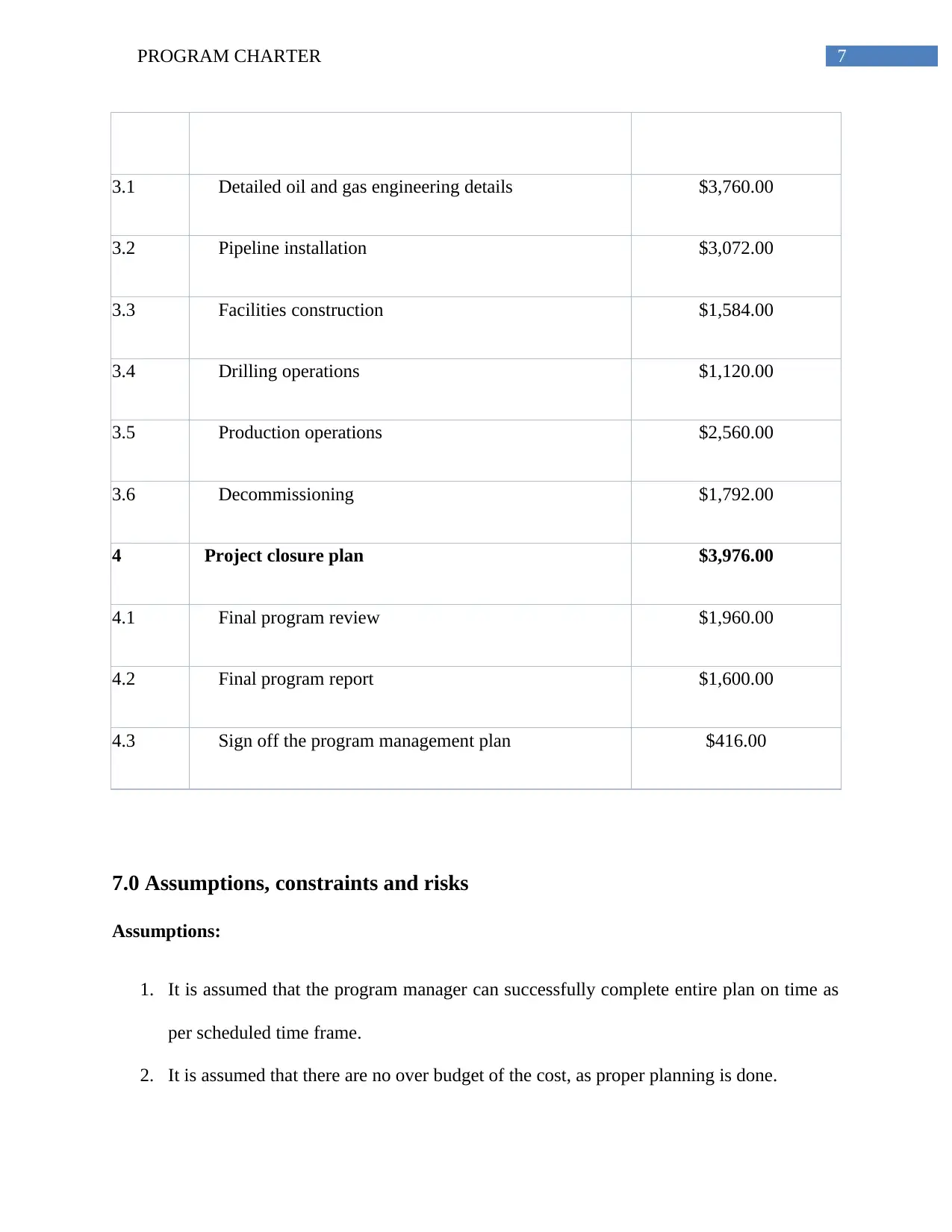
7PROGRAM CHARTER
3.1 Detailed oil and gas engineering details $3,760.00
3.2 Pipeline installation $3,072.00
3.3 Facilities construction $1,584.00
3.4 Drilling operations $1,120.00
3.5 Production operations $2,560.00
3.6 Decommissioning $1,792.00
4 Project closure plan $3,976.00
4.1 Final program review $1,960.00
4.2 Final program report $1,600.00
4.3 Sign off the program management plan $416.00
7.0 Assumptions, constraints and risks
Assumptions:
1. It is assumed that the program manager can successfully complete entire plan on time as
per scheduled time frame.
2. It is assumed that there are no over budget of the cost, as proper planning is done.
3.1 Detailed oil and gas engineering details $3,760.00
3.2 Pipeline installation $3,072.00
3.3 Facilities construction $1,584.00
3.4 Drilling operations $1,120.00
3.5 Production operations $2,560.00
3.6 Decommissioning $1,792.00
4 Project closure plan $3,976.00
4.1 Final program review $1,960.00
4.2 Final program report $1,600.00
4.3 Sign off the program management plan $416.00
7.0 Assumptions, constraints and risks
Assumptions:
1. It is assumed that the program manager can successfully complete entire plan on time as
per scheduled time frame.
2. It is assumed that there are no over budget of the cost, as proper planning is done.
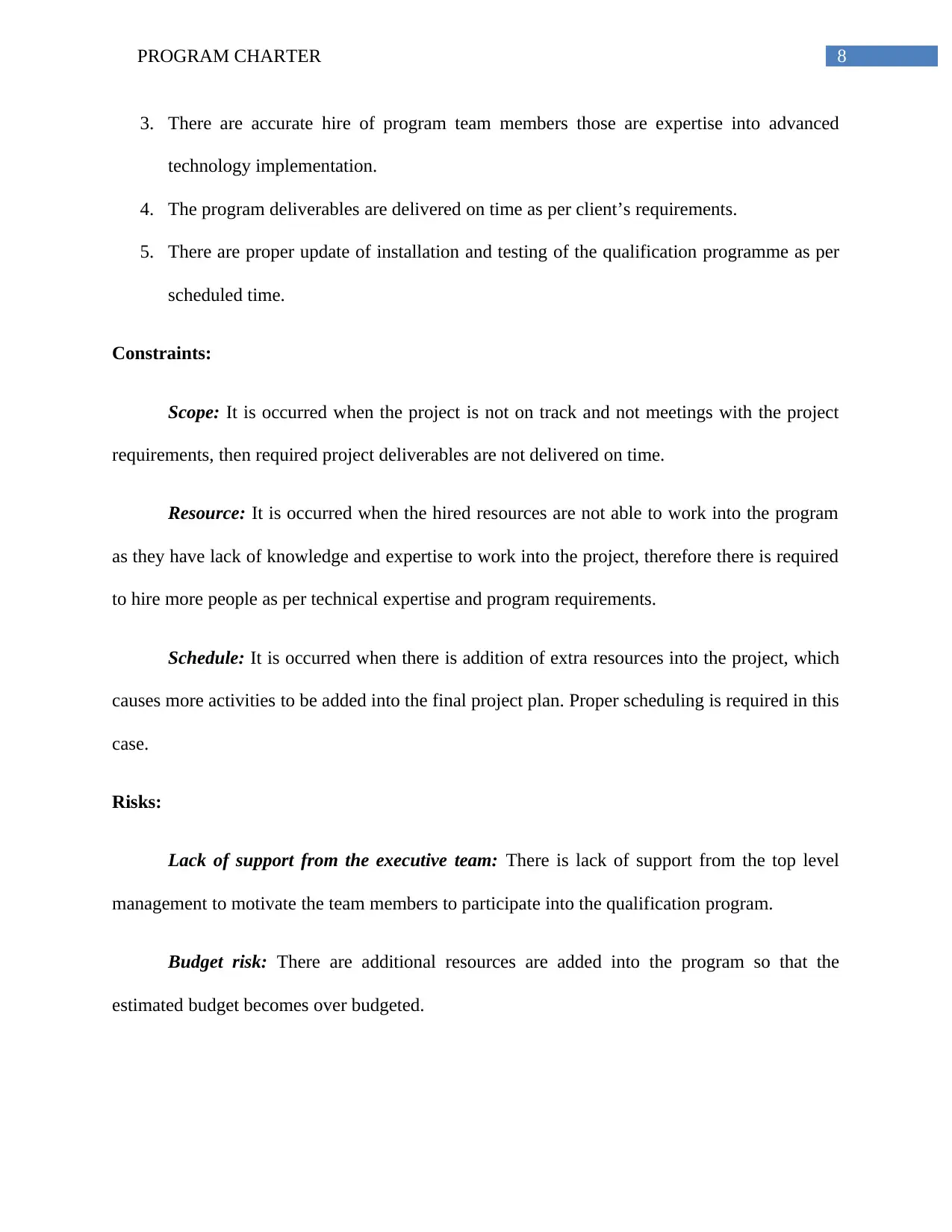
8PROGRAM CHARTER
3. There are accurate hire of program team members those are expertise into advanced
technology implementation.
4. The program deliverables are delivered on time as per client’s requirements.
5. There are proper update of installation and testing of the qualification programme as per
scheduled time.
Constraints:
Scope: It is occurred when the project is not on track and not meetings with the project
requirements, then required project deliverables are not delivered on time.
Resource: It is occurred when the hired resources are not able to work into the program
as they have lack of knowledge and expertise to work into the project, therefore there is required
to hire more people as per technical expertise and program requirements.
Schedule: It is occurred when there is addition of extra resources into the project, which
causes more activities to be added into the final project plan. Proper scheduling is required in this
case.
Risks:
Lack of support from the executive team: There is lack of support from the top level
management to motivate the team members to participate into the qualification program.
Budget risk: There are additional resources are added into the program so that the
estimated budget becomes over budgeted.
3. There are accurate hire of program team members those are expertise into advanced
technology implementation.
4. The program deliverables are delivered on time as per client’s requirements.
5. There are proper update of installation and testing of the qualification programme as per
scheduled time.
Constraints:
Scope: It is occurred when the project is not on track and not meetings with the project
requirements, then required project deliverables are not delivered on time.
Resource: It is occurred when the hired resources are not able to work into the program
as they have lack of knowledge and expertise to work into the project, therefore there is required
to hire more people as per technical expertise and program requirements.
Schedule: It is occurred when there is addition of extra resources into the project, which
causes more activities to be added into the final project plan. Proper scheduling is required in this
case.
Risks:
Lack of support from the executive team: There is lack of support from the top level
management to motivate the team members to participate into the qualification program.
Budget risk: There are additional resources are added into the program so that the
estimated budget becomes over budgeted.
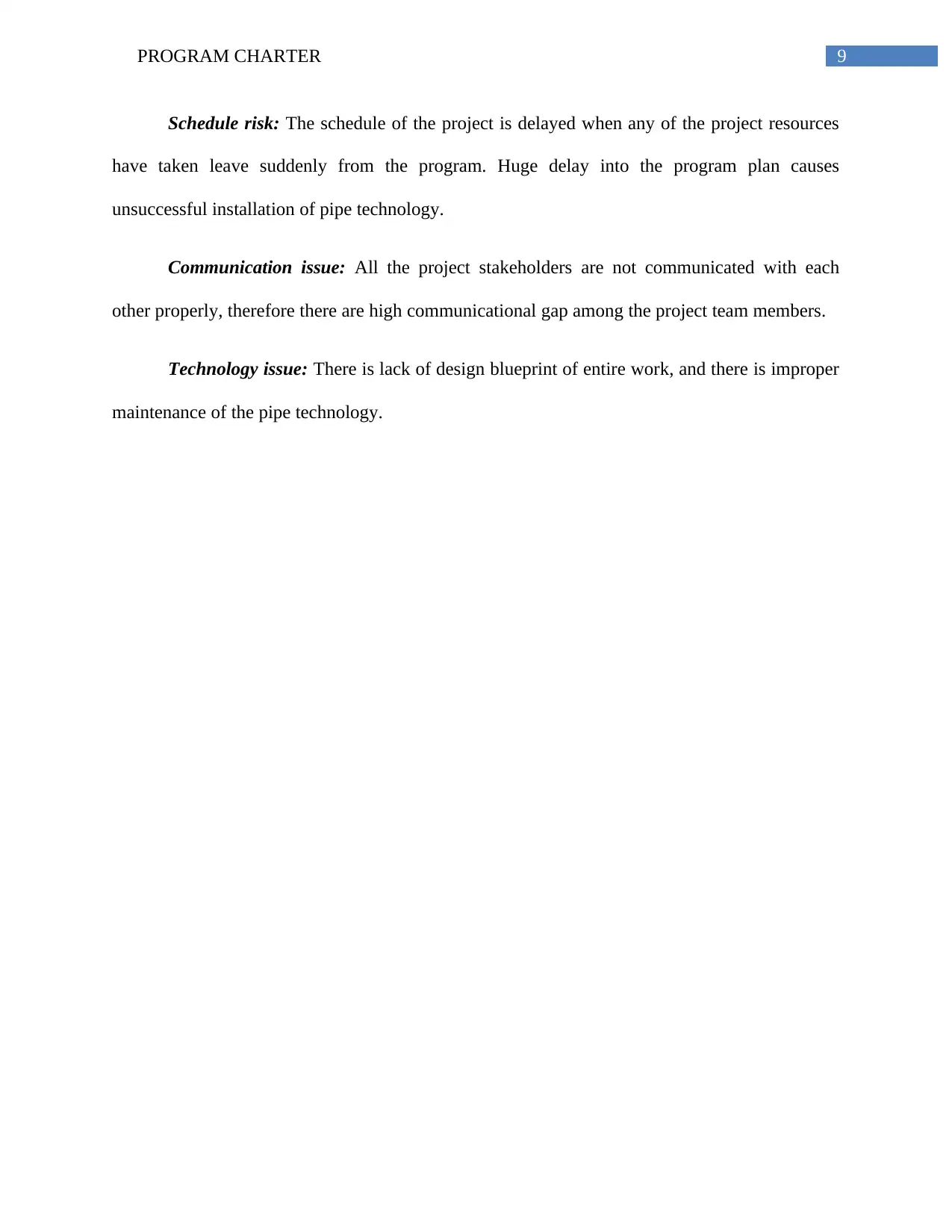
9PROGRAM CHARTER
Schedule risk: The schedule of the project is delayed when any of the project resources
have taken leave suddenly from the program. Huge delay into the program plan causes
unsuccessful installation of pipe technology.
Communication issue: All the project stakeholders are not communicated with each
other properly, therefore there are high communicational gap among the project team members.
Technology issue: There is lack of design blueprint of entire work, and there is improper
maintenance of the pipe technology.
Schedule risk: The schedule of the project is delayed when any of the project resources
have taken leave suddenly from the program. Huge delay into the program plan causes
unsuccessful installation of pipe technology.
Communication issue: All the project stakeholders are not communicated with each
other properly, therefore there are high communicational gap among the project team members.
Technology issue: There is lack of design blueprint of entire work, and there is improper
maintenance of the pipe technology.
Secure Best Marks with AI Grader
Need help grading? Try our AI Grader for instant feedback on your assignments.
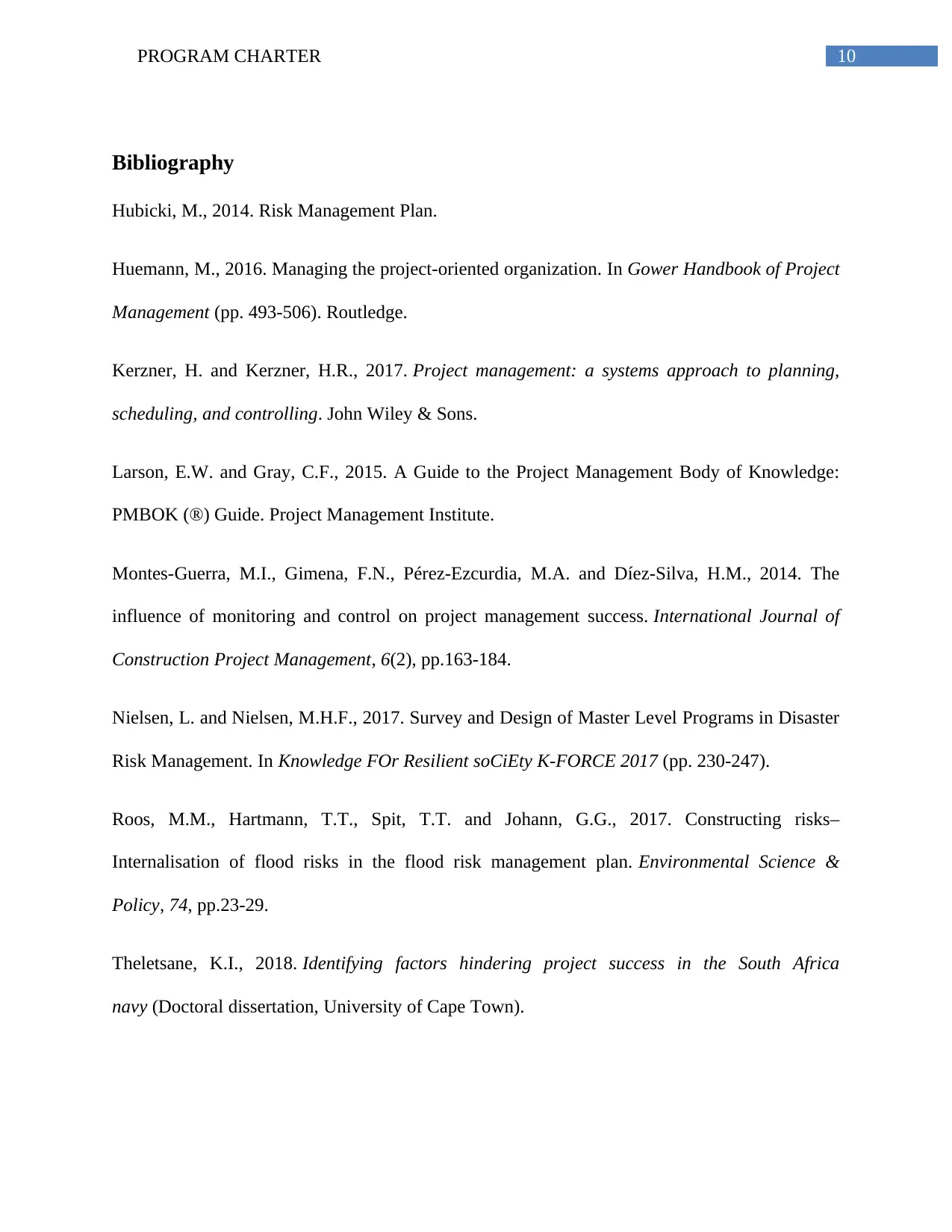
10PROGRAM CHARTER
Bibliography
Hubicki, M., 2014. Risk Management Plan.
Huemann, M., 2016. Managing the project-oriented organization. In Gower Handbook of Project
Management (pp. 493-506). Routledge.
Kerzner, H. and Kerzner, H.R., 2017. Project management: a systems approach to planning,
scheduling, and controlling. John Wiley & Sons.
Larson, E.W. and Gray, C.F., 2015. A Guide to the Project Management Body of Knowledge:
PMBOK (®) Guide. Project Management Institute.
Montes-Guerra, M.I., Gimena, F.N., Pérez-Ezcurdia, M.A. and Díez-Silva, H.M., 2014. The
influence of monitoring and control on project management success. International Journal of
Construction Project Management, 6(2), pp.163-184.
Nielsen, L. and Nielsen, M.H.F., 2017. Survey and Design of Master Level Programs in Disaster
Risk Management. In Knowledge FOr Resilient soCiEty K-FORCE 2017 (pp. 230-247).
Roos, M.M., Hartmann, T.T., Spit, T.T. and Johann, G.G., 2017. Constructing risks–
Internalisation of flood risks in the flood risk management plan. Environmental Science &
Policy, 74, pp.23-29.
Theletsane, K.I., 2018. Identifying factors hindering project success in the South Africa
navy (Doctoral dissertation, University of Cape Town).
Bibliography
Hubicki, M., 2014. Risk Management Plan.
Huemann, M., 2016. Managing the project-oriented organization. In Gower Handbook of Project
Management (pp. 493-506). Routledge.
Kerzner, H. and Kerzner, H.R., 2017. Project management: a systems approach to planning,
scheduling, and controlling. John Wiley & Sons.
Larson, E.W. and Gray, C.F., 2015. A Guide to the Project Management Body of Knowledge:
PMBOK (®) Guide. Project Management Institute.
Montes-Guerra, M.I., Gimena, F.N., Pérez-Ezcurdia, M.A. and Díez-Silva, H.M., 2014. The
influence of monitoring and control on project management success. International Journal of
Construction Project Management, 6(2), pp.163-184.
Nielsen, L. and Nielsen, M.H.F., 2017. Survey and Design of Master Level Programs in Disaster
Risk Management. In Knowledge FOr Resilient soCiEty K-FORCE 2017 (pp. 230-247).
Roos, M.M., Hartmann, T.T., Spit, T.T. and Johann, G.G., 2017. Constructing risks–
Internalisation of flood risks in the flood risk management plan. Environmental Science &
Policy, 74, pp.23-29.
Theletsane, K.I., 2018. Identifying factors hindering project success in the South Africa
navy (Doctoral dissertation, University of Cape Town).
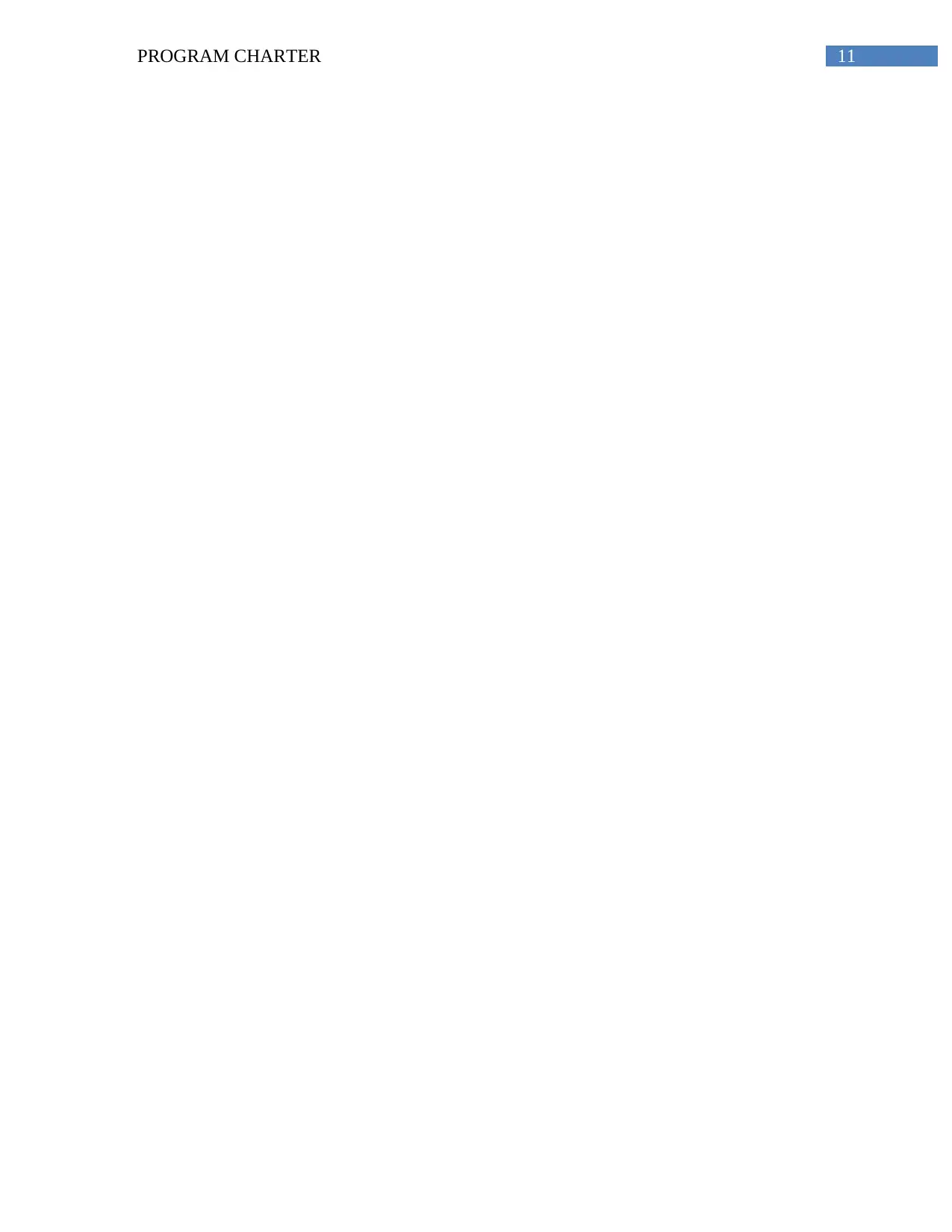
11PROGRAM CHARTER
1 out of 12
Your All-in-One AI-Powered Toolkit for Academic Success.
+13062052269
info@desklib.com
Available 24*7 on WhatsApp / Email
![[object Object]](/_next/static/media/star-bottom.7253800d.svg)
Unlock your academic potential
© 2024 | Zucol Services PVT LTD | All rights reserved.


